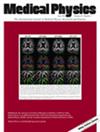Two-step beam geometry optimization for volumetric modulated arc therapy gantry angles in breast treatments
Abstract
Background
In partial arc volumetric modulated arc therapy (VMAT) for treating breast cancer, setting up the limiting gantry positions of the treatment machine is a nontrivial yet repetitive and time-consuming task during planning. Templatized solutions exist but may not provide adequate plan quality.
Purpose
We have developed a two-step beam geometry optimization (2SBGO) method to set up in an automated manner the VMAT start/stop gantry angles and avoidance sector (AvS) angle limits for breast treatments. We compare our preliminary results of 2SBGO to manually created plans.
Methods
In the first step of the method (based on patient geometry), the initial angles are obtained either from a template, from machine-learning (ML) predictions or manually. A search range around the initial positions is specified for each angle. In the second step (refinement using dosimetric criteria), the parameters are optimized using generalized simulated annealing (GSA). As objective function for GSA, we used the optimizer cost. We tested the method for deep inspiration breath hold and free breathing patients for left- and right-sided breast treatments. As ML models, we trained convolutional neural networks to predict the angles (start/stop angles for both the partial arc and the avoidance sector limits). The training set size was up to 86 patients, the validation set size was fixed to six patients and the test set size to six patients. The initial input before preprocessing was in DICOM format (RT plan and structure files and CT images). The rationale for using ML as first step is to learn from data the ways the beam angles are set and evaluate how good the initial ML solution would be for the final plan quality.
Results
We showed that for all the test patients, the 2SBGO leads to plans that are of a comparable dosimetric quality compared with manual plans while eliminating the complex and time-consuming beam geometry (BG) set-up step. Additionally, with the optimization function we used in our approach the ipsilateral lung doses in right-sided treatments are reduced compared with plans with manual angle selection. The ML models were shown to be most useful in a clinical workflow when integrated in the full 2SBGO scheme. The ML models themselves, before the second optimization step, predicted the medial angle within accuracy 3.6° ± 2.6° (mean ± SD) and the AvS limiting values within 10.8° ± 8.3°. The Wilcoxon paired signed-rank test indicated that there were no statistically significant differences between the distributions of ML predictions and manual choices.
Conclusions
We can obtain in an automatic fashion clinically acceptable breast treatment plans, dosimetrically comparable with the manual ones, by combining an initial BG set-up with a dosimetric refinement step for the beam angles. The initial ML-based plans are a useful starting point while they need further refining which the dosimetric fine-tuning provides. The work paves the way to the automation of the BG setup that has the potential for considerable savings of planner's time, and a decrease in the variation of the quality of the plans.

 求助内容:
求助内容: 应助结果提醒方式:
应助结果提醒方式:


